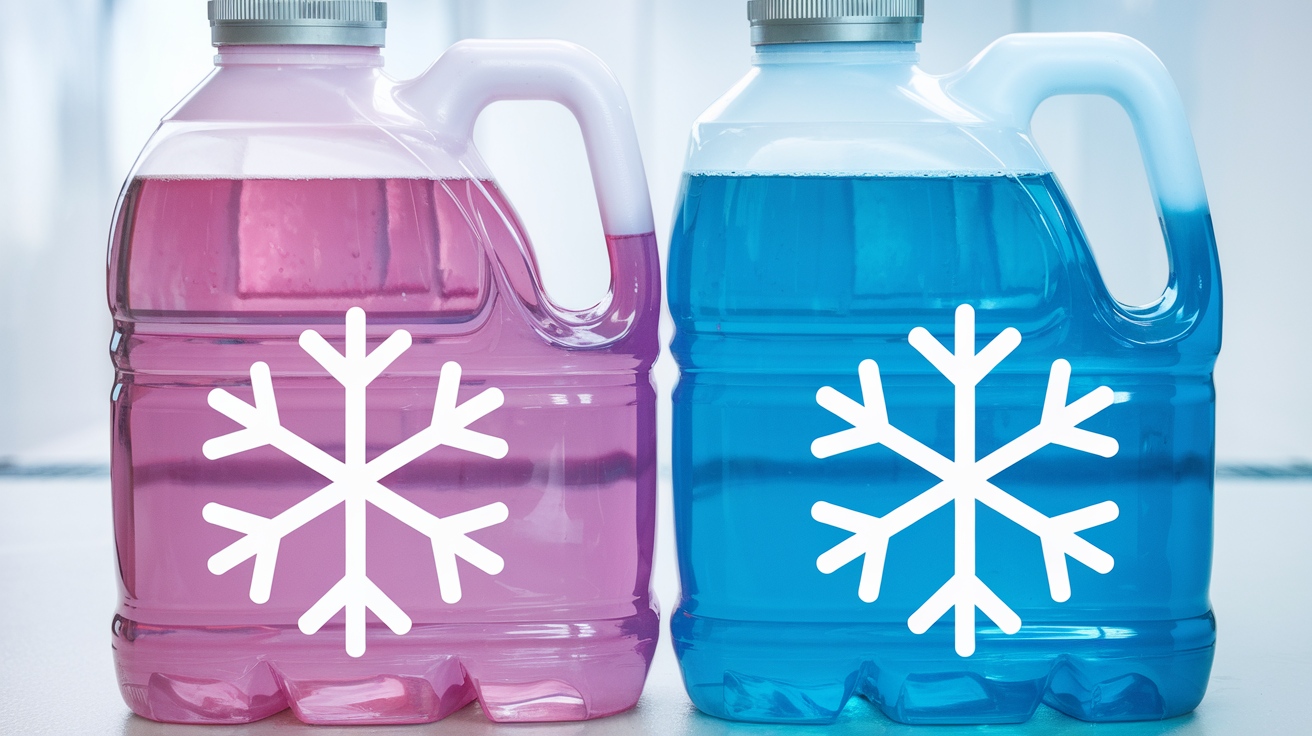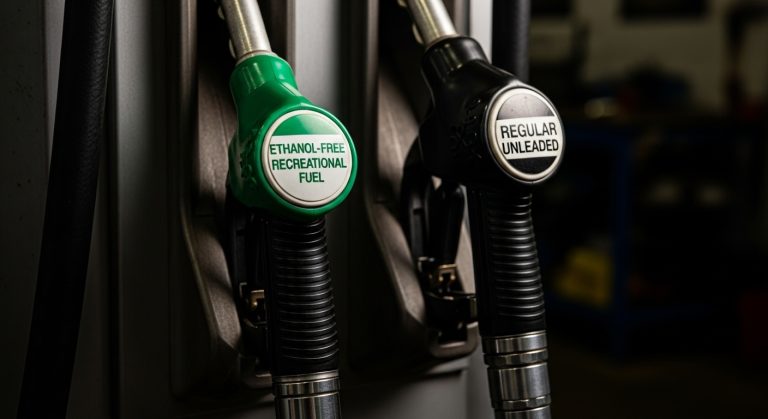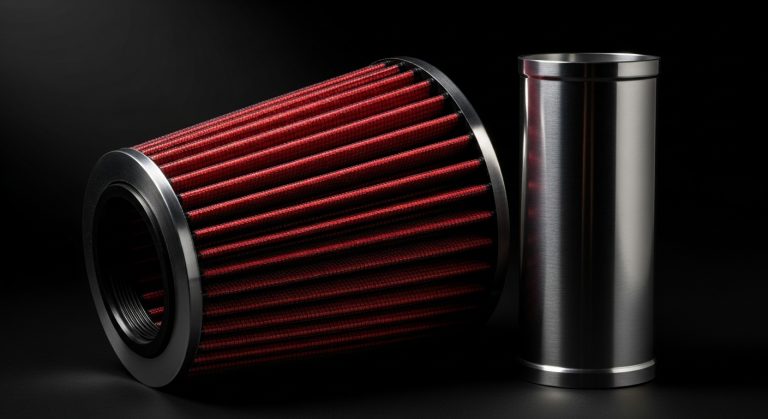Antifreeze and coolant are often used interchangeably, but there’s a distinction. Antifreeze is a concentrated liquid that lowers the freezing point of your engine’s coolant. Coolant is the mixture of water and antifreeze, essential for regulating engine temperature. It helps prevent overheating and freezing while protecting engine components. Different types, like ethylene glycol and propylene glycol, serve specific purposes. Understanding their roles can enhance your vehicle’s performance. There’s more to explore about them and how they work together.
Key Takeaways
- Antifreeze is a component of coolant, typically made of ethylene glycol or propylene glycol, mixed with water for optimal performance.
- Coolant is the final mixture of antifreeze and water, essential for regulating engine temperature and preventing overheating or freezing.
- Different types of antifreeze (IAT, OAT, HOAT) are suited for various vehicle models and age, impacting coolant longevity and performance.
- The standard mixing ratio of coolant is 50:50, balancing protection against freezing and overheating for efficient engine operation.
- Proper maintenance of coolant levels is crucial, as insufficient antifreeze can lead to engine damage and decreased fuel efficiency.
Understanding Coolant and Antifreeze
When you consider the cooling system in your vehicle, it’s vital to understand the roles of coolant and antifreeze.
Coolant is fundamentally a mixture of water and antifreeze, typically ethylene glycol or propylene glycol, combined with additives to prevent rust and corrosion. Pre-mixed coolant usually contains 50% water and 50% antifreeze, ready for immediate use.
While antifreeze prevents freezing, coolant also transfers heat efficiently, guaranteeing peak engine performance. It’s significant to note the distinction; antifreeze is just one component of coolant. Additionally, different types of antifreeze come in various types—such as IAT, OAT, and HOAT—identified by their color and additive packages. Understanding these components helps promote proper maintenance of your vehicle’s cooling system.
The Role of Antifreeze in Engine Performance
Antifreeze plays a vital role in engine performance by regulating temperature and protecting components under varying conditions. It lowers the freezing point and raises the boiling point of coolant, preventing freezing in cold temperatures and overheating in heat.
This temperature enhancement guarantees your engine operates efficiently, regardless of seasonal changes or extreme climates. Antifreeze also contains additives that prevent corrosion, protecting internal components from damage and enhancing engine longevity.
Proper coolant maintenance is fundamental, as antifreeze loses its chemical efficacy over time. By maintaining proper antifreeze levels and concentration, you support smooth engine operation, improve fuel efficiency, and contribute to overall engine health. Essentially, antifreeze is essential for peak performance throughout the year.
Types of Antifreeze and Their Applications
When choosing antifreeze, it’s essential to understand the differences between ethylene glycol and propylene glycol. Ethylene glycol offers excellent performance but poses significant toxicity risks, while propylene glycol provides a safer, environmentally friendly alternative.
Additionally, comparing Inorganic Acid Technology (IAT) with Organic Acid Technology (OAT) helps you select the right type for your vehicle’s specific needs. Coolants are essential for maintaining optimal engine temperatures and preventing overheating during operation.
Ethylene Glycol Overview
Understanding ethylene glycol is essential for anyone involved in vehicle maintenance or HVAC systems. This alcohol-based organic compound offers superior thermal conductivity and lower viscosity, enabling efficient heat transfer. Engine coolant is a mixture of antifreeze and water that circulates through the engine to dissipate heat and prevent overheating.
Ethylene glycol antifreeze comes in concentrated forms, typically requiring dilution with water, and is available in various colors, such as green, blue, or pink, depending on additives. It’s imperative for automotive cooling systems to prevent overheating and freezing, while also playing a significant role in HVAC systems for temperature regulation.
However, be aware of its high toxicity, which poses significant risks to pets and children if ingested. Proper handling, storage, and disposal are necessary to mitigate environmental impact and safety hazards.
Propylene Glycol Benefits
Propylene glycol serves as a versatile alternative to ethylene glycol in various antifreeze applications, offering distinct advantages due to its non-toxic nature. Its hygroscopic properties and miscibility with water enhance its suitability across multiple industries. Here’s a quick overview of its benefits:
| Feature | Propylene Glycol | Ethylene Glycol |
|---|---|---|
| Toxicity | Non-toxic | Toxic |
| Environmental Impact | Safer for pets and wildlife | Harmful if ingested |
| Flash Point | Higher flash point | Lower flash point |
| Applications | Automotive, food, cosmetics | Primarily automotive |
| Chemical Stability | Converts to harmless compounds | Converts to toxic metabolites |
Using propylene glycol in your systems guarantees safety and efficiency, making it an excellent choice for antifreeze applications. Furthermore, engine coolant plays a crucial role in preventing overheating, further enhancing the overall effectiveness of propylene glycol in automotive systems.
IAT Vs OAT Antifreeze
Antifreeze plays an important role in maintaining your vehicle’s engine temperature, and choosing the right type is vital for peak performance.
When it comes to antifreeze, you’ll encounter two main types: IAT and OAT.
- IAT (Inorganic Additive Technology): Ideal for older vehicles, typically bright green, with a lifespan of 2 years or 25,000-30,000 miles.
- OAT (Organic Acid Technology): Suited for newer vehicles, available in various colors like orange or red, lasting 3-5 years before replacement. OAT coolants allow for longer intervals between changes, making them a more convenient choice for many drivers.
- Mixing Issues: Never mix IAT and OAT, as it compromises effectiveness.
Selecting the appropriate antifreeze guarantees maximum protection and longevity for your engine components, aligning with manufacturer specifications.
Make an informed choice for your vehicle’s needs.
Importance of Mixing Ratios for Optimal Performance
While maintaining your vehicle’s cooling system, it’s essential to pay attention to the mixing ratios of antifreeze and water, as these ratios directly influence engine performance.
A standard 50:50 ratio offers balanced protection against freezing and overheating, ensuring maximum cooling efficiency. You can customize this ratio using concentrated antifreeze based on your climate conditions, but remember that pure antifreeze has a higher boiling point than water, which can affect cooling. Engine coolant mixtures vary based on climate and boiling point, so it’s crucial to adjust the ratio accordingly.
Insufficient antifreeze increases the risk of corrosion, while incorrect ratios can lead to engine damage and higher maintenance costs.
For best results, always use distilled water and consult your vehicle’s manual for specific recommendations to maintain your engine’s health and performance.
Seasonal Considerations for Coolant and Antifreeze
Understanding the seasonal variations in coolant and antifreeze is essential for maintaining your vehicle’s cooling system effectively. Adjusting the antifreeze concentration based on seasonal changes guarantees peak engine performance.
- In winter, a higher concentration of antifreeze prevents freezing and engine damage.
- During summer, antifreeze raises the boiling point of coolant, preventing overheating.
- Regularly check coolant levels before each season to assure proper function.
- Remember, engine coolant is a mixture of water and antifreeze that plays a crucial role in managing your engine’s temperature year-round.
Chemical Properties and Safety Considerations
Chemical properties play a vital role in the effectiveness and safety of coolant and antifreeze. Ethylene glycol, commonly used in antifreeze, lowers the freezing point and raises the boiling point, enhancing thermal conductivity and flow. In contrast, propylene glycol offers a less toxic alternative, making it safer for both humans and the environment.
Additives like corrosion inhibitors further protect engine components while ensuring peak performance. However, it’s essential to handle antifreeze carefully due to the high toxicity of ethylene glycol; improper disposal can contaminate the environment. Always follow local regulations for disposal, and seek immediate medical attention in case of accidental exposure.
Insufficient coolant can lead to engine overheating, highlighting the importance of maintaining proper levels in your vehicle’s cooling system. Understanding these properties helps you make informed choices for your vehicle’s cooling system.
Frequently Asked Questions
Can I Use Water Instead of Coolant in My Vehicle?
You might think using water instead of coolant is a quick fix, but it can lead to serious engine issues.
Water freezes at 32°F and boils at 212°F, which can cause overheating or cracking in extreme temperatures. Additionally, it lacks corrosion inhibitors and can introduce impurities that damage your engine.
In emergencies, water may work temporarily, but you should replace it with proper coolant as soon as possible to guarantee your engine’s longevity and performance.
How Often Should I Replace My Coolant?
You should replace your coolant every 30,000 to 100,000 miles or every two to five years, depending on your manufacturer’s recommendations.
Regularly check your coolant levels and condition to guarantee peak performance. If you notice rising temperature gauge readings, rust or debris in the reservoir, or frequently need to add coolant, it’s time to replace it.
Always consider your vehicle’s age, coolant type, and driving habits when determining replacement intervals.
Is It Safe to Mix Different Antifreeze Types?
Oh sure, mixing different antifreeze types sounds like a fun experiment, right?
But in reality, it’s risky. If you mix incompatible antifreeze, you could cause serious engine damage or clog your cooling system.
It’s essential to check the chemical ingredients and follow manufacturer recommendations. Always verify compatibility before mixing.
If you’re unsure, it’s safer to flush the system and use the correct type. Your engine will thank you later!
What Symptoms Indicate Coolant Issues in My Engine?
If you’re experiencing coolant issues, watch for a rising temperature gauge, steam from the hood, or white exhaust smoke—these could signal overheating or leaks.
Low coolant levels often accompany these symptoms, leading to further engine complications.
Regularly needing to refill the coolant reservoir or spotting leaks under your vehicle also indicates problems.
Ignoring these signs can cause significant engine damage, so it’s essential to address any coolant issues immediately.
Can Antifreeze Damage My Car’s Paint?
Can antifreeze really damage your car’s paint? Yes, it can. If antifreeze sits on your car’s surface for too long, especially in heat, it can dissolve the paint and cause discoloration. To minimize damage, you should remove any spills immediately. Regular waxing can provide a protective barrier, but be cautious—ethanol and propylene glycol aren’t paint-friendly. Always clean your vehicle promptly to maintain its appearance and protect its finish.
Antifreeze and Coolant: Your Engine’s Secret to Longevity and Performance
In the dance of engine performance, antifreeze and coolant play crucial roles. Understanding their differences and applications guarantees your vehicle runs smoothly, like a well-tuned orchestra. Remember to mix them in the right ratios, adapting to the seasonal shifts, for ideal protection against the elements. By considering chemical properties and safety measures, you not only safeguard your engine but also your wallet. So, embrace the harmony of antifreeze and coolant, and keep your ride singing through every mile.




